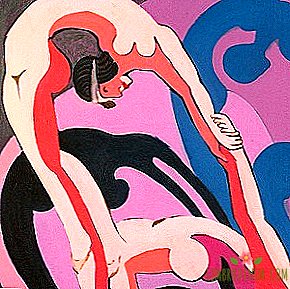Mourners and screaming: Who are they and why they are needed today
THEME OF DEATH REMAINS SUCH A POWERFUL CULTURAL the taboo that interest in her continues to be considered "unhealthy", and her very - too "gloomy" to discuss seriously. At the same time, death is one of the few areas where traditions are still alive, such as the Orthodox custom of arranging a funeral on the third day and a wake on the ninth and fortieth day after death. One of the customs - to hire mourners, special people who must grieve about the deceased - is gradually becoming a thing of the past. We decided to find out how this tradition has changed over time and what this occupation may mean for understanding funerals and the culture of grief.
Text: Alisa Zagryadskaya

Background
The tradition to call people to the funeral especially for them to grieve for the deceased, originates in antiquity. For example, in ancient Egypt, where funeral practices played a large role, the image of mourners was associated with Isis, who mourns for Osiris. For the funeral, they hired special mourners (in other versions, it could be local women who were familiar with the deceased, but not relatives, who simply decided to join the procession) - two of them spoke on behalf of the goddesses Isis and Nephthys. The mourners carried flowers, food, and oils; some could carry furniture and clothing that should have been left in the tomb. In Assyria, it was customary to violently express grief for the dead: not only family members, but also mourners, who opened the funeral procession with the musicians, wept and sprinkled ashes on their heads.
Funeral rites with music and funeral singing also existed in ancient Greece and Rome. For example, in describing Hector’s funeral in the Iliad, Homer mentions singers who performed funeral songs, and women echoed them in tears. In Paul Giro's book "The Private and Social Life of the Romans" (a collection of excerpts from the works of historians and ancient authors) describes the burial of the Roman citizen. They were invited to hire a mourner from the temple of Venus Libitina, who sang "funeral" songs to the sounds of flutes and lyres. The mourners also participated in the funeral procession, led by the mother of the deceased with her daughters and daughter-in-law. The mourners describe it like this: "Their dress was in disarray, their hair was loose, they poured abundant tears and let out cries of despair." The maids who joined the procession were trained by a professional mourner on how to grieve for the deceased.
Voplenitsy in Russia
Orthodoxy historically related to crying at a funeral with distrust - for example, John Chrysostom condemned the tradition to invite mourners to them, which was associated with pagan customs. In the Christian world its place is occupied by church hymns, the rite of burial. Instead of excessive grief, one must pray for the repose of the soul of the deceased — it is believed that grief should be quiet and inconspicuous.
Nevertheless, there were also mourners in Russia, even if they were not approved by the church - they were called voilers. This occupation was female: women were considered to be symbolic guardians of the hearth, rituals, practices, life cycles — all associated with the land that yields the harvest and the host body after death. Traditional lamentations were called "honored speech." The compilation "Northern Faiths", compiled at the end of the nineteenth century by the ethnographer Elpidifor Barsov, contains funeral, tombstone and gravestones lamentations - poems to the death of a loved one with a characteristic rhythmic pattern. Here's how, for example, the lines of crying over the dead daughter sound: "As the sun is lost for a little cloud, / May also hide from the little child; / As the month dawns, the moon disappears in the morning, / My white swan flew away On the other unknown zhivlynitse! "

A good vocalist should have the gift of speech, acting skills, have a strong voice. Called cryers, who were famous for their talent, were invited from other villages.
The lamentations were transmitted from mouth to mouth and differ from region to region, from performer to performer. In the book of Barsov, poems are interspersed with remarks like "when he returns home he addresses the girls and screams ...", "then he turns to his father", "going out to the middle of the hut". It turns out that the vocalizer was not only a “mouthpiece” for the grief of those present and helped to “lead” the deceased into the world of the dead - she also performed the role of ritual administrator, where everyone had their own place and role.
A good vocalist had to have the gift of speech, acting skills, to have a strong voice - according to folklorist Svetlana Adoneva, special respiratory techniques are used in weeping. Called cryers who were famous for their talent were invited from other villages - but, as Svetlana Adonyeva notes, they did not ask for money: the occupation was perceived as a mission, and not as a job. Having read about someone from the dead for the first time, the woman seemed to undergo an initiation, after which she could decide whether to wail only about the deceased family members or to become a famous mourner, who was called to the funeral of her neighbors. Today the culture of the mourners is dying off, although members of folklore expeditions have recorded laments in recent decades.

Grief culture
In the film "The Lord of the Rings" sounds crying for Gandalf, performed by the elves of Lorien. In fact, the wizard did not die and would return in white, but the elves and the Fellowship of the Ring do not yet know about it. "What do they sing about him?" - asks the hobbit Merry. “I cannot convey this,” replies Legolas. “My pain is still too acute.” In response, Merry, who also wants to have his say, compiles simple and touching poems about how great Gandalf started the fireworks. All this is logical in the world of Tolkien, the inspiration for which was the ancient legends and epics.
Modern people have much more difficult. Traditional rituals are in the past, and secular city dwellers are virtually defenseless in the most difficult moments. At funerals, besides grief and pain, people often feel insecure, embarrassed and embarrassed because they do not know how to “need” to behave and what to do with stunning feelings.
Manifestations of negative emotions in modern culture are taboo, but the unlived pain remains inside, which is why people can face it again and again. Traditions associated with the funeral, on the contrary, help to “legally” live the pain, not hesitating their feelings. According to anthropologist Bronislav Malinowski, the task of the funeral rites is the removal of anxiety, which naturally causes death. From another point of view, their task is also to create anxiety, recalling the inevitability of death and the importance of life.

Often, young women left for work in other cities and did not have time to return to the funeral of a relative - for these cases, the family hired a mourner, "replacement" daughter
Perhaps that is why in some countries mourners and mourners are still found today. For example, women professionally engaged in this in Ghana say they help relatives who are unable to mourn the loss help them cry. This work is done by widows, they take payment according to the scale of the funeral.
Modern Chinese mourners and mourners are more like a troupe of artists who not only sing, but also dance, theatrically depict grief, sobbing and stretching their arms. The ceremony is structured in such a way as to create at first a gloomy atmosphere that helps the relatives of the deceased to throw out the grief and then comfort and calm them. Liu Jun-Lin, a professional mourner from Taiwan, where the art of wailing is fading away, also believes that it helps relatives of the deceased to realize and feel the loss: "When a dear person dies, you experience so much grief that when it comes to burial, there are no tears, - She says. - How can you drastically restructure and show all the sadness that you feel? " The tradition of the mourners in the country is connected with the organization of society: often young women left for work in other cities and did not have time to return to the relative’s funeral - for these cases the family hired a mourner’s “replacement” daughter. Liu's work also looks more like a theatrical performance, but according to the woman herself, she cries for real every time and tries to feel the grief of others.
In Japan, there is a service that is difficult to attribute to the traditional practices of mourners, although in part it is close to them. Ikemeso Danshi (coarsely translated as "beautiful weeping men") offers "tear therapy" that should help a woman survive a divorce. A man comes to the users of the service, with whom they are watching a film that should help them cry, live through heavy emotions, and then feel better.

The experience of loss for all happens in different ways - there are no right and wrong ways. Someone loudly mourning and even silent tears at the tomb may seem inappropriate, but someone, on the contrary, will help
In other countries, the services of mourners are becoming more symbolic - they are needed not so much to live the grief as to comply with the formalities. For example, the British site Rent A Mourner offers the services of actors who depict guests at funerals and funerals, if the organizers for some reason need it. There is no talk of tears and rolling on the ground here - on the contrary, the company promises to send "reserved" people, who will discuss with the relatives of the deceased an acceptable strategy of behavior. True, those who do this professionally note that they also help the relatives and friends of the deceased, even if this is not their task at all - simply because funerals imply communicating with other people about difficult events.
Many theorists and practitioners of death studies - death sciences - draw attention to the "funeral alienation" and problems with modern farewell rituals. The funeral expert and author of the books, Caitlin Doughty, founded the Order of Good Death, the goal of which is to create a more open and relaxed attitude to death and help families organize a farewell where they can be personally involved in the process. In Moscow, recently opened Death Cafe (a branch of the "social franchise" that exists in at least 65 countries), or the "death cafe", at these meetings, anyone can discuss the topic.
The experience of loss for all happens in different ways - there are no right and wrong ways. Someone loudly mourning and even silent tears at the tomb may seem inappropriate, but on the contrary, they will help someone. Talking about the fading tradition of funeral weeping is an occasion to think about how practitioners who can survive a loss can be rebuilt in the modern world. The main thing is that attitudes towards grief and death in general should not be on the list of forbidden topics.
Photo: Wikimedia (1, 2, 3, 4), loc (1, 2)





